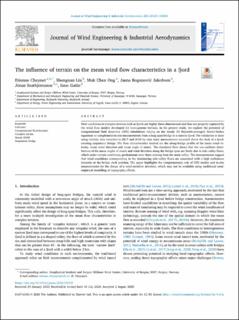| dc.contributor.author | Cheynet, Etienne | |
| dc.contributor.author | Liu, Shengnan | |
| dc.contributor.author | Ong, Muk Chen | |
| dc.contributor.author | Jakobsen, Jasna Bogunovic | |
| dc.contributor.author | Snæbjörnsson, Jonas Thor | |
| dc.contributor.author | Gatin, Inno | |
| dc.date.accessioned | 2021-03-22T08:16:05Z | |
| dc.date.available | 2021-03-22T08:16:05Z | |
| dc.date.created | 2020-08-03T11:05:08Z | |
| dc.date.issued | 2020 | |
| dc.Published | Journal of Wind Engineering and Industrial Aerodynamics. 2020, 205 . | |
| dc.identifier.issn | 0167-6105 | |
| dc.identifier.uri | https://hdl.handle.net/11250/2734647 | |
| dc.description.abstract | Flow conditions in complex terrains such as fjords are highly three-dimensional and thus not properly captured by the wind flow models developed for homogenous terrains. In the present study, we explore the potential of computational fluid dynamics (CFD) simulations relying on the steady 3D Reynolds-averaged Navier-Stokes equations to complement in-situ measurements from a long-span bridge in a narrow fjord. The validation is done using velocity data recorded in 2017 and 2018 by nine sonic anemometers mounted above the deck of a fjord-crossing suspension bridge. The flow characteristics studied are the along-bridge profile of the mean wind velocity, mean wind direction and mean angle of attack. The simulated flow shows that the non-uniform distributions of the mean angles of attack and wind direction along the bridge span are likely due to side-valley flows, which under certain conditions, predominate over those coming from the main valley. The measurements suggest that wind conditions corresponding to the dominating side-valley flows are associated with a high turbulence intensity at the bridge deck position. The paper highlights the complementary role of CFD studies and in-situ measurements for the design of a wind-sensitive structure, which may not be available using traditional semi-empirical modelling of topography effects. | en_US |
| dc.language.iso | eng | en_US |
| dc.publisher | Elsevier | en_US |
| dc.relation.uri | https://www.sciencedirect.com/science/article/pii/S0167610520302415?via%3Dihub | |
| dc.rights | Navngivelse 4.0 Internasjonal | * |
| dc.rights.uri | http://creativecommons.org/licenses/by/4.0/deed.no | * |
| dc.title | The influence of terrain on the mean wind flow characteristics in a fjord | en_US |
| dc.type | Journal article | en_US |
| dc.type | Peer reviewed | en_US |
| dc.description.version | publishedVersion | en_US |
| dc.rights.holder | Copyright 2020 The Authors. | en_US |
| dc.source.articlenumber | 104331 | en_US |
| cristin.ispublished | true | |
| cristin.fulltext | original | |
| cristin.qualitycode | 1 | |
| dc.identifier.doi | 10.1016/j.jweia.2020.104331 | |
| dc.identifier.cristin | 1821265 | |
| dc.source.journal | Journal of Wind Engineering and Industrial Aerodynamics | en_US |
| dc.source.40 | 205 | |
| dc.identifier.citation | Journal of Wind Engineering and Industrial Aerodynamics. 2020, 205, 104331. | en_US |
| dc.source.volume | 205 | en_US |

